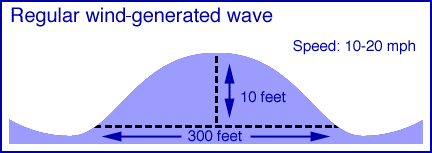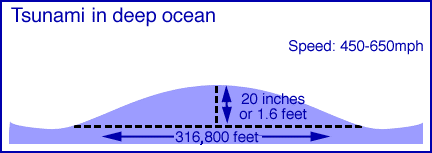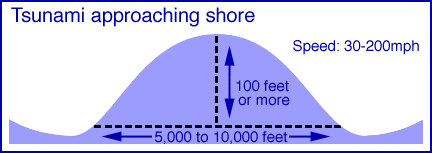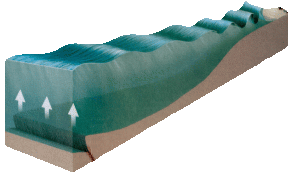Deep Sea Waves vs Other Water Waves
Because their ratio of the water depth to the wavelength (the distance
from one crest to the next) is small, tsunamis act as shallow water waves, and
differ greatly in their behavior from surface ocean waves which are caused
primarily by wind. Waves cause by wind, such as in storms, can have a larger (5
-10 m) amplitude (height of the wave from crest to trough) than the deep sea
tsunamis (<1 m). However deep-sea tsunamis characteristically have extremely
long wavelengths (10 – 500 km) and period (the time it takes to move one
wavelength, ~1 hr). The amplitude
and wave length are determined by the strength of the disruption and the contour
of the ocean floor.
The speed (c) of the wave is the square root of the depth of the water (H) times acceleration of gravity (g):
Ocean depths are typically around 4000m, so deep water
tsunami speeds are about 200 m/s or 700 km/hr.
The energy loss of a tsunami equals the inverse of the wavelength, so they can move at high speeds for long distances without loosing much energy. This allows them to efficiently propagate across an ocean.



http://library.thinkquest.org/C0110220/original/index.html
Approaching a Land Mass
When they approach a land mass and the water depth decreases rapidly, the tsunami slows rapidly due to the same relationship to depth and gravity. However, because they loose so little energy as they travel, as they slow their amplitude or the wave height increases. This increase in wave height in shallow water (hs) is related to the original height in the deep water (hd) and the depths of the deep (Hd) and shallow water (Hs).
So a tsunami with a wave
height of 1 m at 4000m deep will have a height of ~ 8 m when it reaches shallow
water at 1 m deep. This would be high enough to reach up to the third story of a
building.
How It Hits a Coast Line
As the wave moves onto land it begins to loose energy at a faster rate due to friction and turbulence, however it still hits the shore with a considerable energy. The way that the wave appears as it moves up the shore is largely dependent on the contour of the sea floor and whether the it breaks on a wave crest or trough. It can appear as a rapid tidal rise and fall, or a series of breaking waves, resulting in a massive amount of water surging up the shore and across the land.

http://www.mbhs.edu/~jedunn/Thinkquest/en/disaster/tsunami/physics.html
The amount and nature of the destruction tsunamis cause in dependent on the on the geomorphology of the landscape. Often they cause severe erosion, clearing land of vegetation and structures, carrying debris both inland and out to sea.

